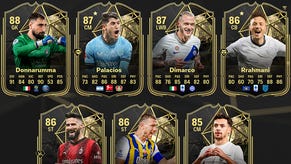EA Sports FC 24 makes big changes off the pitch - but what about on it?
Hypermotion V! Precision Passes! PlayStyles! Actual Career Mode changes! POV refs?!
Brace yourself: EA Sports has been at the proper nouns cupboard again. This year, EA Sports FC 24 - the replacement for FIFA 24 - is bringing a range of off-pitch enhancements, which I will smash through with as much combined detail and swiftness as is appropriate below. But on the pitch, having played quite a few games of standard, one-on-one friendlies against an old friend-slash-rival, I'm not sure it feels hugely different.
The general sentiment in the room, out at EA Sports' big reveal event in Amsterdam ("the home of modern football"), is that it was maybe a bit slower, that there are some neat new animations, and that much of this pre-beta press build will probably - and naturally, given how early it is and how important balance is - be completely changed by the time the game launches this September anyway.
Still, we go again. This year, EA Sports executive producer John Shepherd says, is set to be the "biggest leap in technology and immersion that football has ever seen." There's lots of talk about EA Sports' big buzzwords for the year - "authenticity and innovation", plus a slightly worrying obsession with triangles - but in real terms, that results in a range of changes to just about every mode, including, would you believe it, Career Mode too.
First up though, from a technical angle, the biggest jump with FC 24 is the move from capturing player movements and building in-game animations from people in motion capture suits, to an AI-driven process of capturing the matchday movement of actual players in top divisions, using numerous cameras dotted around stadiums and working from that direct data.
Previously, EA actually used capture from the Spanish 2nd and 3rd divisions, to which they had the rights, but that's now replaced with this new process of "volumetric motion" - dubbed Hypermotion V, for the proper noun fans; don't ask what the V stands for, the last one was Hypermotion 2 - that uses data from over 1,200 players. It also replicates specific moments from the real world, an example being Erling Haaland's unconventional, over-stretched shot against Andre Onana in the Champions League final that was then displayed to us in-game. At one point it was mentioned that when consulting with a real-world anatomy expert, FIFA's players were up to 7cms out compared to actual humans - that's now down to within "a few millimetres" in FC 24. Volumetric motion, EA says, has been in the works for "at least five years" behind the scenes.
There's also been some significant work done on player physiques - Adama Traore was shown in one dramatic before-and-after, now looking appropriately jacked - and the addition of something called GPU Cloth, which despite the silly name did look fantastic up close, with kits, including shirts, sleeves, and shorts, moving considerably more naturally compared to the more static, waxwork effect of old player models. Digital Foundry aficionados might also take interest in a lighting feature called GTAO (Grand Truth Ambient Occlusion, not GTA Online), for added depth to the visuals.
Matches are now also fancier looking overall - in pause menus, which like a lot of menus in FC 24 are dramatically slimmed down, there are a range of behind-the-scenes clips of players in dressing rooms playing to one side - and Ultimate Team will continue to fill stadiums with ridiculous tat. There's also a fancy, if slightly pointless overlay when the ball goes out of play, providing one of several stats "powered by Opta", the analytics company behind a lot of stats you see on actual broadcasts, including a particularly interesting "win probability" figure based on how you're playing, and the usual stuff like possession, fatigue and shot locations - the idea being to reduce the amount of pausing you'll need to do to check in on how your players are faring. Match of the Day's Guy Mowbray and ITV's Sue Smith join the commentary team - Smith being the first female co-commentator in FIFA/FC history, and there's some more realistic-sounding audio.

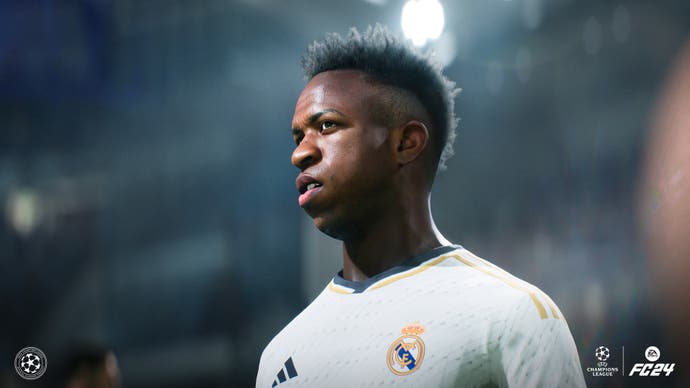
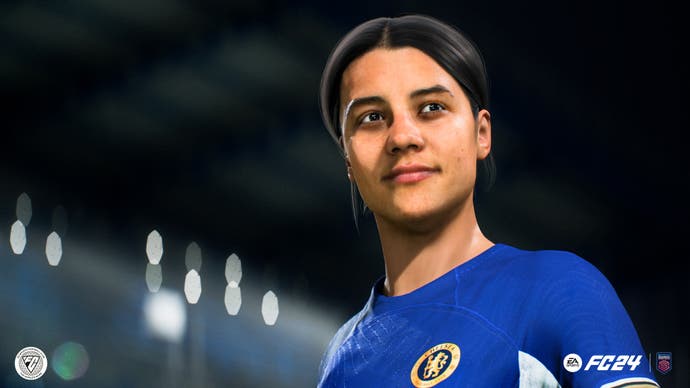
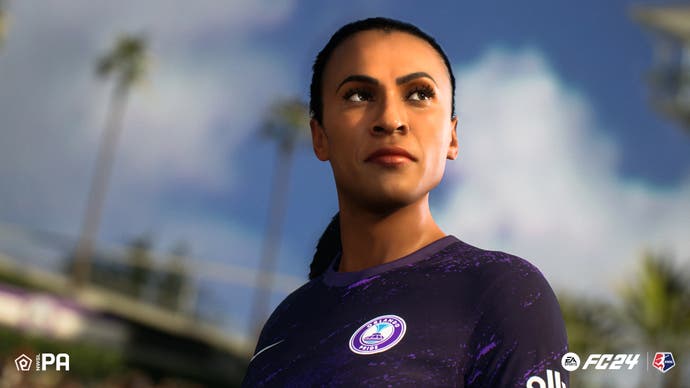
Sticking with menus, this is arguably where FC 24 is at its most different to FIFA 23, which sounds odd but given how truly frustrating FIFA menus could be, is maybe some of the best news from the entire presentation. Gone are the tiles, and Liliia Mandrino, UX design director, says this revamp was all about "getting out of players' way", which is welcome. There's a new "Smartstart" feature the seems to be automatically adaptive in some way, and a small switcher menu that acts as a series of shortcuts to certain modes.
Career mode meanwhile has been reframed as two modes, albeit the two that effectively already existed: Manager Career and Player Career. Player Career's big addition is agents - you can now set target clubs with your agent and they'll give you a set of objectives, like scoring a certain number or type of goals, to earn yourself a new contract or a move to some other club you're eying up.
Manager Career mode gets a bigger revamp, something FIFA's smaller but no less loud contingent of offline-only players have been after for a while. That's the good news. The bad news is that the revamp seems to mostly manifest itself as more training modes in between matches, which I'm unsure anybody in the world - even the career mode fans - actually want to play. This manifests itself as a series of deeply Football Manager-like additions like an overall team philosophy - Tiki taka, Gegenpressing, Counter-attacking, Park the bus were some shown - that effectively act like tactics presets to reduce the amount of tinkering from the off. There's also a new coaches system, with them each having a rating out of five stars - very FM - and where that extra training comes in: Match preparation.
You'll now get pre-match reports on every opponent you face, telling you how they play and allowing you to use drills to target specific things that might impact opposition strengths and weaknesses. The how of that takes me onto the one big change to actual gameplay this year: Playstyles.

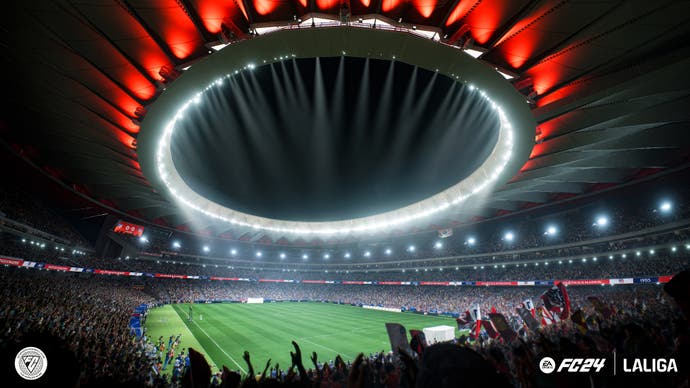
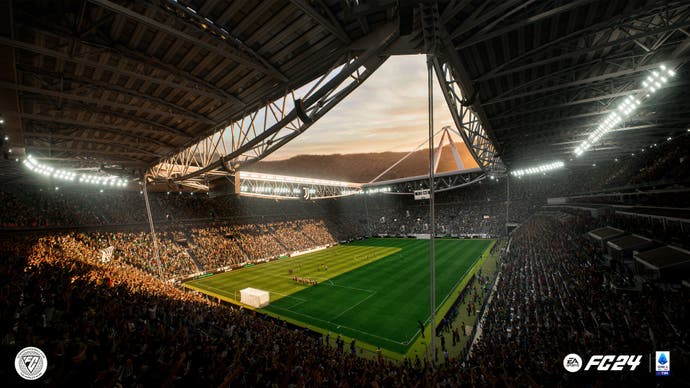
Playstyles are effectively the Player Traits of old, that you might remember from games back in the FIFA 13 era. There are 34 of these in total, and each of them also has a "plus" version for the very best players in the world. Examples are Trickster, which lets players use unique flicks, animations, and tricks, and Trickster+ that lets them use even more. Speed Dribbler was shown in an in-engine race, showing players with that Playstyle significantly out-pacing other players running with the ball, while Block or Block+ is effectively a passive boost to a player's ability to automatically block shots more effectively. Power Header, Power Shot, Finesse Shot were some of the others on display.
How that ties into your match preparation is fairly interesting: say your upcoming opponent is using a Park the Bus tactic, meaning a low block of lots of players crowding the edge of their box to try and shut you out - one option would be to set up some drills that temporarily give your player the Technical Dribbler Playstyle that lets them have much more close ball control to weave through the crowd.
Notably, none of these 34 PlayStyles will involve the so-called Mental Attributes that the series has struggled to capture - the "Thomas Muller effect" where some players, because their strengths lie more in tactical nous than technical or physical attributes, just don't really work as well in FIFA. Mason Mount might be a more current example: a player valued for his ability to trigger a press well and execute complex tactical instructions more than his good-but-not-amazing technical qualities on the ball.
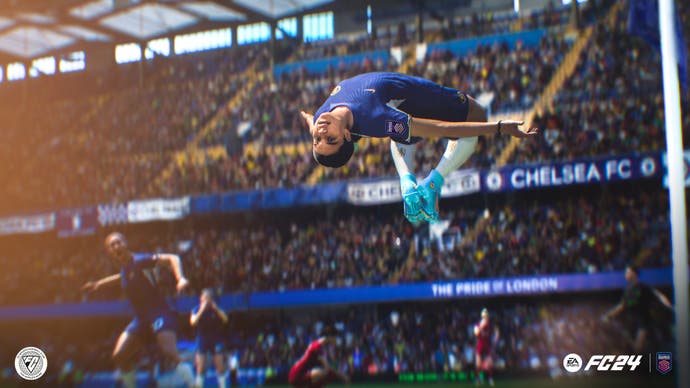
I asked Sam Riveira, EA Sports' senior producer on the gameplay side of things, about how the developer approached this. In his words, "In 24, the focus is on five different areas: passing, shooting, ball control, defending, and goalkeeper. For the future there could be more - I'm pretty sure there's gonna be more - which will expand to other areas like Mental. For now the focus is mainly on the execution of those things, like what's your passing accuracy, can you do first-time passes, can you control the ball in acrobatic ways?" For now though, expect them to stick to those five groups.
PlayStyles are also present in every part of the game, working differently in each mode. In your personal player career mode you can earn them for your player, in manager career it's these temporary buffs they provide, and in the dreaded Ultimate Team, there's another big change: you can now "evolve players" over time by completing objectives, giving you what EA described as "unique versions nobody else has."
The example given here was Borussia Dortmund's Moukoko going from a 69-rated silver card, to 77 overall, and then finally 85, after you completed "evolution paths" to level him up. These are still quite rigid, mind, and not available for just any player. Instead, EA Sports will pick out Squad Builder Challenge-style objectives and requirements, like a Silver Bundesliga player with a certain overall rating, which narrows things down quite significantly, so it's hard to see this really blowing the meta wide open. The stages of these evolutions - like Moukoko's jumps in OVR rating - will be spread out over the various FUT seasons through the year.
Another major change: womens' football players are coming to Ultimate Team, and will be mixed in with mens players. It's a fascinating change - female footballers will keep their overall and specific attribute ratings, so Sam Kerr of Chelsea, in my time with the game, had the same 91 overall as Kylian Mbappe of PSG (although note that these ratings were non-final at the time). Their chemistry will be handled by the fairly obvious move to simply give them a chemistry link if they're next to a player from the same club - like Kerr and Raheem Sterling, both of Chelsea.
Riveira explained it like this: "If you have different players, but they have the same attributes - the same height, and the same weight - they will behave the same, it doesn't matter if it's men or women, exactly the same. And then from there, there's just differences in player sizes and player weight and height." In Riveira's eyes, despite that sounding like the typically more physically imposing mens' players might immediately take precedent in online play, that won't necessarily be the case. "You also want players that are agile, for example if you're a defender, you still need to be able to jockey, you still need to be able to catch up, so it really is going to widen the pool of players that people will be selecting in their Ultimate Teams." How does the team solve the problem of potential toxicity there, which seems depressingly inevitable in a game like FC? Riviera could only speak "in terms of gameplay," but in his words, "we just see it as a huge addition that we're all very, very excited about."
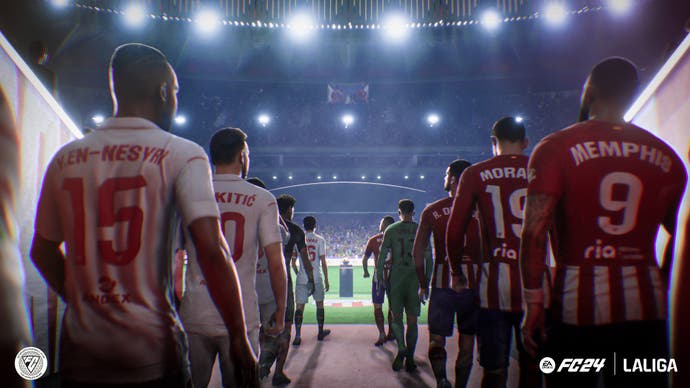
Other tweaks include Icon's chemistry system being improved, giving them a chemistry contribution for any league. And the position modifier has been completely removed, with you now seemingly able to change player's positions at will.
For the lesser-spotted Pro Clubs and and Volta modes there are also some tweaks - for one Pro Clubs is now just called Clubs, but more importantly, cross-play is now available across all consoles, although it's locked to generations for now. That's available in all match types, which should add to the number of players you can match with and therefore give you slightly more well-balanced games, in theory - which should help with a new Divisions Rivals-style leagues system, where you can gradually climb leagues but not get demoted. Crucially, you can now get some ridiculous sunglasses and stadium tat with Club Identity and V Pro Identity systems, which bring a bit of RPG-fication to the one mode that was previously spared, and these will of course allow you to earn and equip new PlayStyles once more.
And breathe. Bringing all of this back to the actual video game - playing football! - and FC 24 feels… quite good. PlayStyles are noticeable but perhaps only because whenever a player with a certain PlayStyle receives the ball, a little icon representing that bonus pops up over their head. Mbappé for instance, a guy with a little rocket icon appearing to show his pace, actually felt a little sluggish and struggled to really outpace defenders. Despite seeming like an almost identical idea, PlayStyles so far are less noticeable than the arcadey fun of the player traits of old.
Riveira noted, though, that this is a conversation the team is genuinely having constantly. "Absolutely we debate on this - every week, there's a conversation, because it's key. We want to bring real motion, but we know that of course it's a game, it's six minute halves, you need to have fun. So in some areas we make compromises - for example, the referees don't have physics. You can go through the referee."
Another one he gave: "players in the game are slightly faster than real-life players. Why? Because again, the game is six minutes, you need to have fun, so we just need to find the right balance." Basically, Riveira said, "It depends. It's a case-by-case discussion - if it's the referee, well we need to make that call. If it's passing, if it's shooting, after all, it's a game where everyone needs to have fun."
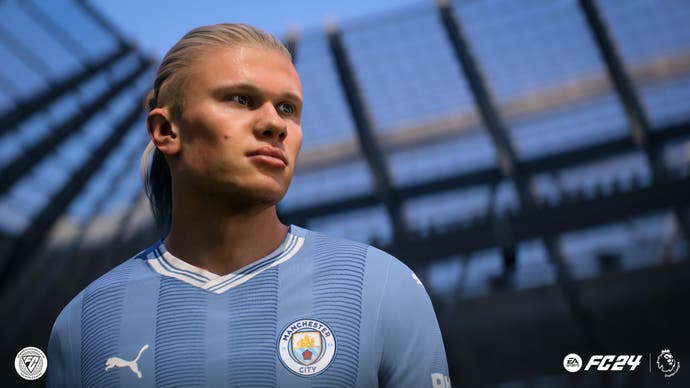
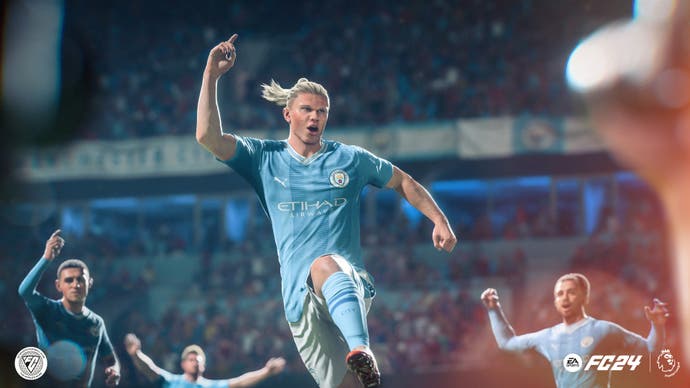
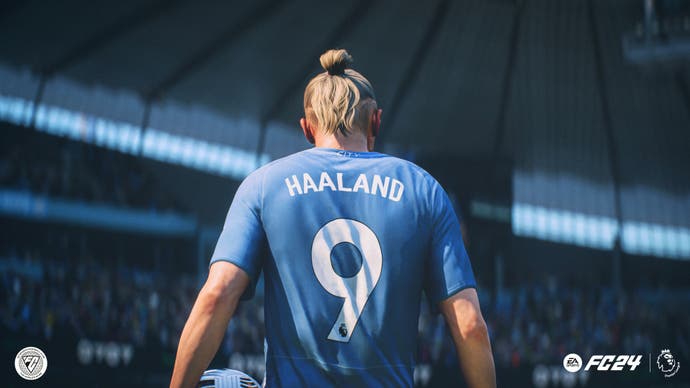
All this said, these PlayStyles will naturally be polished "until September", so it may feel totally different come launch. And arguably most interesting of all anyway was a new type of pass, buried a little in the presentation, that replaces the old "threaded through ball". This time, you can now hold down the RB and Y (R1 and Triangle) to manually direct a through ball or lofted through ball with what's called Precision Passing, and after a little getting used to it is actually a brilliant tool for overcoming frustrations with the in-game players' semi-automated pass directions - a nice way to mix two types of setting you normally have to toggle in the menus within the same match.
The question that comes to mind here is whether PlayStyles, or this new type of pass, are just the latest of a series of gimmicks EA Sports adds each year - a regular criticism levied at the developer by its more cynical players. In previous years, for instance, the talk was all about isolated one-on-one scenarios where the game was built to provide more of those skill-based matchups between an attacker and a defender, and aid defending players by preventing loose balls from going straight back to attackers after a tackle. What happens to those features each year?
"There's different answers," Riveira explained. "Sometimes some mechanics that are not so popular have to be removed," and in the case of things like threaded through balls that's simple because "we don't have enough configurations of the controls to add new stuff." But with those old one-on-one situations, those are still present, and just built on year-on-year. "I remember talking about them - we call it the tackle backs - which is, if you do everything correctly, press B to tackle and then somehow the ball bounces back to the same dribbler - we improved those. Those improvements stay in the game, we continue adding on top."
Generally though, things don't feel too revolutionary and again, may completely change - and that's the thing with FIFA, and now FC 24. Each year the early versions feel a little different, usually slightly slower and more considered, with whatever new feature of the year getting some prominence, until gradually things get faster, and Ultimate Team's arm race begins, until it's almost recognisable. If only it were one, continuously updated live service that could build over time without months of the development cycle dedicated to printing discs and passing certification, these tweaks might feel more like real progress.







